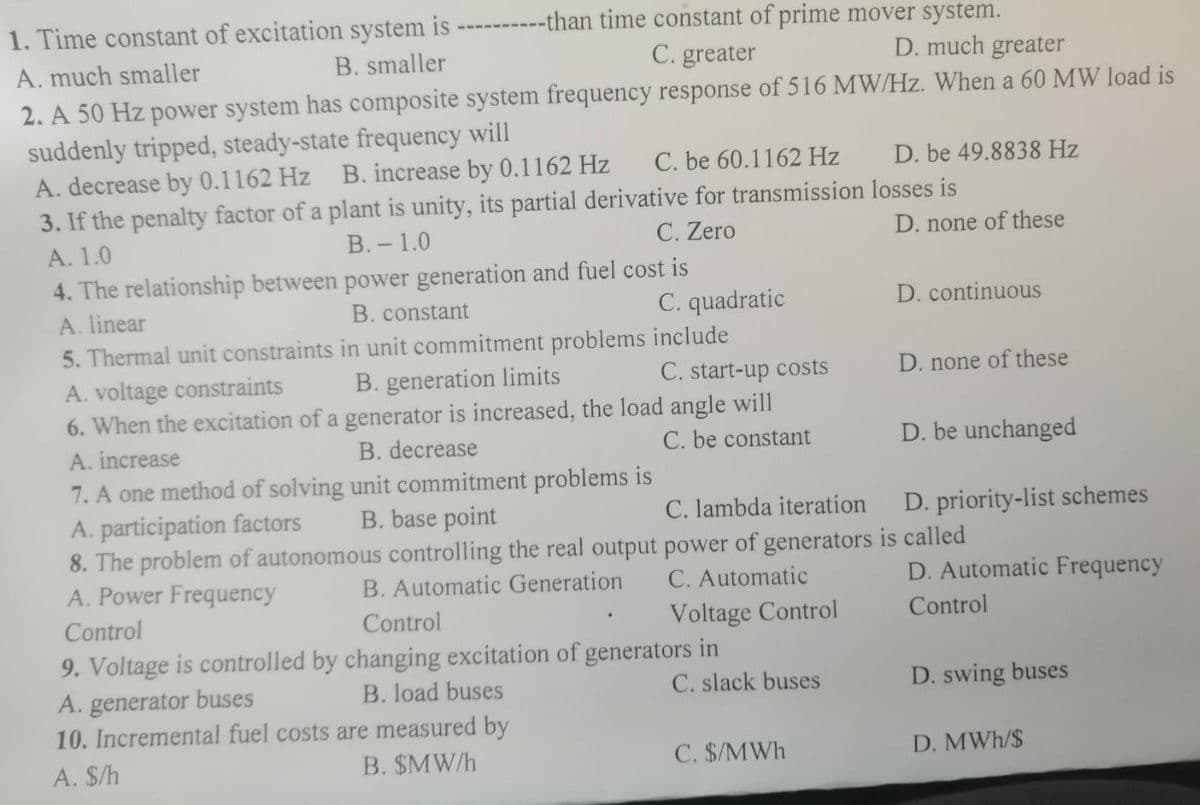-than time constant of prime mover system. D. much greater 1. Time constant of excitation system is A. much smaller B. smaller C. greater 2. A 50 Hz power system has composite system frequency response of 516 MW/Hz. When a 60 MW load is suddenly tripped, steady-state frequency will A. decrease by 0.1162 Hz 3. If the penalty factor of a plant is unity, its partial derivative for transmission losses is B. increase by 0.1162 Hz C. be 60.1162 Hz D. be 49.8838 Hz A. 1.0 B. - 1.0 C. Zero D. none of these 4. The relationship between power generation and fuel cost is A. linear B. constant C. quadratic D. continuous 5. Thermal unit constraints in unit commitment problems include A. voltage constraints 6. When the excitation of a generator is increased, the load angle will B. generation limits C. start-up costs D. none of these A. increase B. decrease C. be constant D. be unchanged 7. A one method of solving unit commitment problems is A. participation factors 8. The problem of autonomous controlling the real output power of generators is called A. Power Frequency B. base point C. lambda iteration D. priority-list schemes B. Automatic Generation C. Automatic D. Automatic Frequency Control Control Voltage Control Control 9. Voltage is controlled by changing excitation of generators in A. generator buses 10. Incremental fuel costs are measured by B. load buses C. slack buses D. swing buses R. $MW/h C. $/MWh D. MWh/$
-than time constant of prime mover system. D. much greater 1. Time constant of excitation system is A. much smaller B. smaller C. greater 2. A 50 Hz power system has composite system frequency response of 516 MW/Hz. When a 60 MW load is suddenly tripped, steady-state frequency will A. decrease by 0.1162 Hz 3. If the penalty factor of a plant is unity, its partial derivative for transmission losses is B. increase by 0.1162 Hz C. be 60.1162 Hz D. be 49.8838 Hz A. 1.0 B. - 1.0 C. Zero D. none of these 4. The relationship between power generation and fuel cost is A. linear B. constant C. quadratic D. continuous 5. Thermal unit constraints in unit commitment problems include A. voltage constraints 6. When the excitation of a generator is increased, the load angle will B. generation limits C. start-up costs D. none of these A. increase B. decrease C. be constant D. be unchanged 7. A one method of solving unit commitment problems is A. participation factors 8. The problem of autonomous controlling the real output power of generators is called A. Power Frequency B. base point C. lambda iteration D. priority-list schemes B. Automatic Generation C. Automatic D. Automatic Frequency Control Control Voltage Control Control 9. Voltage is controlled by changing excitation of generators in A. generator buses 10. Incremental fuel costs are measured by B. load buses C. slack buses D. swing buses R. $MW/h C. $/MWh D. MWh/$
Power System Analysis and Design (MindTap Course List)
6th Edition
ISBN:9781305632134
Author:J. Duncan Glover, Thomas Overbye, Mulukutla S. Sarma
Publisher:J. Duncan Glover, Thomas Overbye, Mulukutla S. Sarma
Chapter12: Power System Controls
Section: Chapter Questions
Problem 12.5P
Related questions
Question
i need the answer quickly

Transcribed Image Text:--than time constant of prime mover system.
D. much greater
1. Time constant of excitation system is
A. much smaller
B. smaller
C. greater
2. A 50 Hz power system has composite system frequency response of 516 MW/Hz. When a 60 MW load is
suddenly tripped, steady-state frequency will
A. decrease by 0.1162 Hz B. increase by 0.1162 Hz
3. If the penalty factor of a plant is unity, its partial derivative for transmission losses is
C. be 60.1162 Hz
D. be 49.8838 Hz
А. 1.0
В.- 1.0
C. Zero
D. none of these
4. The relationship between power generation and fuel cost is
A. linear
B. constant
C. quadratic
D. continuous
5. Thermal unit constraints in unit commitment problems include
C. start-up costs
6. When the excitation of a generator is increased, the load angle will
C. be constant
A. voltage constraints
B. generation limits
D. none of these
A. increase
B. decrease
D. be unchanged
7. A one method of solving unit commitment problems is
A. participation factors
8. The problem of autonomous controlling the real output power of generators is called
A. Power Frequency
B. base point
C. lambda iteration
D. priority-list schemes
B. Automatic Generation
C. Automatic
D. Automatic Frequency
Control
Control
Voltage Control
Control
9. Voltage is controlled by changing excitation of generators in
A. generator buses
10. Incremental fuel costs are measured by
B. load buses
C. slack buses
D. swing buses
A. $/h
B. $MW/h
C. $/MWh
D. MWh/$
Expert Solution
This question has been solved!
Explore an expertly crafted, step-by-step solution for a thorough understanding of key concepts.
Step by step
Solved in 2 steps with 1 images

Knowledge Booster
Learn more about
Need a deep-dive on the concept behind this application? Look no further. Learn more about this topic, electrical-engineering and related others by exploring similar questions and additional content below.Recommended textbooks for you

Power System Analysis and Design (MindTap Course …
Electrical Engineering
ISBN:
9781305632134
Author:
J. Duncan Glover, Thomas Overbye, Mulukutla S. Sarma
Publisher:
Cengage Learning

Power System Analysis and Design (MindTap Course …
Electrical Engineering
ISBN:
9781305632134
Author:
J. Duncan Glover, Thomas Overbye, Mulukutla S. Sarma
Publisher:
Cengage Learning